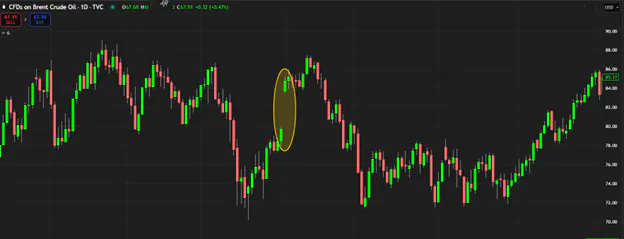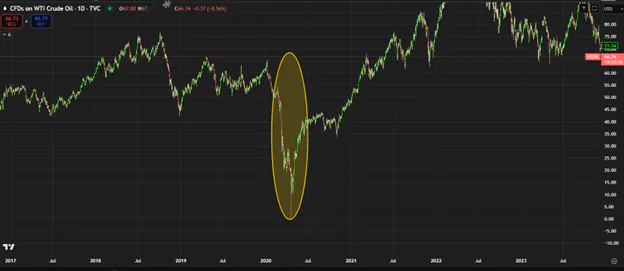
Crude Realities: Understanding oil prices and how to trade them
Jorell Low, Dealer | Contract for Differences
Jorell graduated from the National University of Singapore with a Bachelor’s degree with Honours in Business Administration (Accountancy). He is passionate about trading and enjoys exploring new strategies while staying up to date with market trends. He believes that with the right mindset and discipline, anyone can become a profitable trader.
Crude oil is one of the most actively traded and closely watched assets in the world. More than just a commodity, oil is deeply intertwined with supply-demand dynamics, geopolitics, market speculation, and macroeconomic trends. This makes it a key driver of price action across currencies, equities and inflation expectations.
To CFD traders, oil offers a rare combination of liquidity, volatility, and macro sensitivity, making it both a high risk and high opportunity market. Successful trading requires understanding what truly moves oil prices.
Why Oil matters to CFD Traders
Oil isn’t just the fuel for cars and factories; it’s a barometer of the global economy. From transportation and manufacturing to energy and agriculture, fluctuations in oil prices impact almost every major industry and financial instruments.
Key benefits of trading oil CFDs:
- High liquidity – consistent trading volume leading to tighter spreads
- Strong volatility – frequent price swing creates opportunities, ideal for short-term trading
- Macro exposure – oil reflects major economic trends like inflation, growth, geopolitics and more
- Directional flexibility – CFDs allow for both long and short positions
- Access to global benchmarks – trade major oil standards including Brent Crude and WTI crude
For traders looking to capitalise on real-world events, oil CFDs offer one of the most direct and accessible ways to engage with macro-driven price action.
What affects oil prices?
1. Supply side factors
a) OPEC+ (Organisation of the Petroleum Exporting Countries) production quotas: OPEC countries, along with Russia exert significant influence over global oil supply through production quotas. For example, on 3 Apr 2023, a surprise OPEC+ cut of one-million-barrel per day led to a sharp 6% rally in oil prices in a single day [1]. Less supply often causes prices to increase, vice versa.

Source: TradingView [10]
b. US shale production: The US, a top oil producer due to shale drilling, are market driven; they ramp up output when prices are high and cut back when prices fall. According to US Energy Information Administration (EIA), US oil production surpassed 13 million barrels a day in late 2023 (after the OPEC surprise cut) which impacted global supply balances [2].
c. Inventory and storage capacity: inventory levels provide clues about market imbalances, signaling whether the market is oversupplied or undersupplied. Weekly inventory reports from the EIA [3] on Wednesdays and American Petroleum Institute (API) [4] on Tuesdays are useful gauges for traders. Rising stockpiles usually signal an oversupplied market and bearish sentiments on prices, vice versa. Price reactions to these reports are often immediate.
2. Demand side Factors:
a) Global Economic growth: Oil demand correlates strongly with global GDP growth. A booming economy drives energy demand in transport, manufacturing, and industrial sectors. During China’s reopening in early 2023, oil demand surged which pushed prices higher due to expectations of increased consumption [5]. Conversely, during the COVID pandemic, global lockdowns slashed demand, briefly sending prices in the negative in Apr 2020 [6].

Source: TradingView [10]
b. Energy transition and alternatives: the growing shift to renewable energy and electric vehicles introduces long-term structural headwinds to oil demand, particularly in developed markets.
c. Inflation and interest rates: Oil prices often rise during inflation because it’s priced in USD and often used as a hedge, a risk management strategy, for real estate. However, higher interest rates can suppress demand by slowing economic growth. Traders can take note of central bank actions like Federal Rate hikes, inflation data as indirect drivers of oil demand.
Geopolitical risk and global events
Oil markets are extremely sensitive to geopolitical instability, even the threat of a supply disruption can trigger price spikes due to risk premiums. Key regions to watch out for are the middle east (Iran, Iraq, Saudi Arabia, Israel), Russia, Ukraine, and the Strait of Hormuz choke point where around 20% of global oil passes through. For example recent Middle East conflict between Israel and Iran drove oil prices up due to fears of oil supply shortages but a US-brokered ceasefire eased the spike, immediately reducing prices around 6% [7]. Therefore, staying informed on global news can offer traders an advantage.

Source: TradingView [10]
Currency Correlation: The role of the US Dollar
As oil is traded globally in USD, a stronger dollar makes oil costlier in other currencies, which reduces global demand and lower prices. Tracking the US Dollar Index (DXY), an indicator for Dollar strength, can help traders spot trades. Traders can also check the CME FedWatch Tool [8] for the probability of a federal rate change to predict the strength of the Dollar and impact on oil prices. A rate cute typically weakens the Dollar, reducing its demand, causing investors to shift their capital to other areas for better yields, such as oil.

Source: CMEGroup [8]
Speculation, Sentiment and Positioning
Oil is a favourite among institutional investors, hedge funds and algorithms. Large speculative flows can drive prices beyond fundamentals in the short term. Traders can watch the Commodity Futures Trading Commission’s (CFTC) Commitment of Traders (COT) [9] report, released on Fridays, for the changes in speculative net positions on oil, to gain a sense of the institution’s bias and direction.
Oil trading using Contracts for Difference (CFD)
CFDs allow traders to speculate on oil prices without owning the underlying asset. This derivative structure provides access to both WTI and Brent crude benchmarks with advantages such as:
- Leverage to control larger positions with smaller capital
- Short selling opportunities to profit from falling markets
- 24/5 access overlapping with global trading hours
- No physical delivery obligations
Conclusion
Oil is a dynamic asset class influenced by a complex mix of macroeconomic, geopolitical and speculative forces. By staying informed on these forces, and applying technical analysis and risk management, you can turn oil’s volatility into opportunity. Ready to start? Explore oil CFDs and stay updated on market trends with us.
How to get started with POEMS

POEMS’ award-winning suite of trading platforms offers investors and traders more than 40,000 financial products across global exchanges.
Trade Smarter and Faster
With our newly launched POEMS Mobile 3 Trading App
Explore a myriad of useful features including TradingView chartings to conduct technical analysis with over 100 technical indicators available!
Take this opportunity to expand your trading portfolio with our wide range of products including Stocks, CFDs, ETFs, Unit Trusts and more across 15 global exchanges available for you anytime and anywhere to elevate you as a better trader using our POEMS Mobile 3 App!
For enquiries, please email us at cfd@phillip.com.sg.
Reference
[3] https://www.eia.gov/petroleum/supply/weekly/
[4] https://www.api.org/products-and-services/statistics/api-weekly-statistical-bulletin
[6] https://www.eia.gov/todayinenergy/detail.php?id=46336
[8] https://www.cmegroup.com/markets/interest-rates/cme-fedwatch-tool.html
[9] https://www.cftc.gov/MarketReports/CommitmentsofTraders/index.htm
[10] tradingview.com
More Articles
Playing Defence: Diversification in Forex Trading
Learn how strategic planning and risk management can help you navigate the highs and lows of the forex market. Don’t miss out on unlocking the secrets to long-term profitability!
From Boom to Bust: Lessons from the Barings Bank Collapse
Did you know that the collapse of Barings Bank in 1995 was from massive losses incurred by a rogue trader? Delve into the tale of how Nick Leeson’s fraudulent investments sent shockwaves through the financial world.
Japan's Economic Resurgence – Unveiling the Tailwinds Behind Nikkei 225’s Record Leap
Discover the driving forces behind Japan’s market surge, delve into its economic performance and learn how CFD products can help you navigate the Japanese market’s volatility via our article!
Disclaimer
These commentaries are intended for general circulation and do not have regard to the specific investment objectives, financial situation and particular needs of any person. Accordingly, no warranty whatsoever is given and no liability whatsoever is accepted for any loss arising whether directly or indirectly as a result of any person acting based on this information. You should seek advice from a financial adviser regarding the suitability of any investment product(s) mentioned herein, taking into account your specific investment objectives, financial situation or particular needs, before making a commitment to invest in such products.
Opinions expressed in these commentaries are subject to change without notice. Investments are subject to investment risks including the possible loss of the principal amount invested. The value of units in any fund and the income from them may fall as well as rise. Past performance figures as well as any projection or forecast used in these commentaries are not necessarily indicative of future or likely performance.
Phillip Securities Pte Ltd (PSPL), its directors, connected persons or employees may from time to time have an interest in the financial instruments mentioned in these commentaries.
The information contained in these commentaries has been obtained from public sources which PSPL has no reason to believe are unreliable and any analysis, forecasts, projections, expectations and opinions (collectively the “Research”) contained in these commentaries are based on such information and are expressions of belief only. PSPL has not verified this information and no representation or warranty, express or implied, is made that such information or Research is accurate, complete or verified or should be relied upon as such. Any such information or Research contained in these commentaries are subject to change, and PSPL shall not have any responsibility to maintain the information or Research made available or to supply any corrections, updates or releases in connection therewith. In no event will PSPL be liable for any special, indirect, incidental or consequential damages which may be incurred from the use of the information or Research made available, even if it has been advised of the possibility of such damages. The companies and their employees mentioned in these commentaries cannot be held liable for any errors, inaccuracies and/or omissions howsoever caused. Any opinion or advice herein is made on a general basis and is subject to change without notice. The information provided in these commentaries may contain optimistic statements regarding future events or future financial performance of countries, markets or companies. You must make your own financial assessment of the relevance, accuracy and adequacy of the information provided in these commentaries.
Views and any strategies described in these commentaries may not be suitable for all investors. Opinions expressed herein may differ from the opinions expressed by other units of PSPL or its connected persons and associates. Any reference to or discussion of investment products or commodities in these commentaries is purely for illustrative purposes only and must not be construed as a recommendation, an offer or solicitation for the subscription, purchase or sale of the investment products or commodities mentioned.
This advertisement has not been reviewed by the Monetary Authority of Singapore.
CFD Promotion Disclaimer
This promotion is provided to you for general information only and does not constitute a recommendation, an offer or solicitation to buy or sell the investment product mentioned. It does not have any regard to your specific investment objectives, financial situation or any of your particular needs. Accordingly, no warranty whatsoever is given and no liability whatsoever is accepted for any loss arising whether directly or indirectly as a result of your acting based on this information.
Investments are subject to investment risks. The risk of loss in leveraged trading can be substantial. You may sustain losses in excess of your initial funds and may be called upon to deposit additional margin funds at short notice. If the required funds are not provided within the prescribed time, your positions may be liquidated. The resulting deficits in your account are subject to penalty charges. The value of investments denominated in foreign currencies may diminish or increase due to changes in the rates of exchange. You should also be aware of the commissions and finance costs involved in trading leveraged products. This product may not be suitable for clients whose investment objective is preservation of capital and/or whose risk tolerance is low. Clients are advised to understand the nature and risks involved in margin trading.
You may wish to obtain advice from a qualified financial adviser, pursuant to a separate engagement, before making a commitment to purchase any of the investment products mentioned herein. In the event that you choose not to obtain advice from a qualified financial adviser, you should assess and consider whether the investment product is suitable for you before proceeding to invest and we do not offer any advice in this regard unless mandated to do so by way of a separate engagement. You are advised to read the trading account Terms & Conditions and Risk Disclosure Statement (available online at https://www.poems.com.sg/) before trading in this product.








